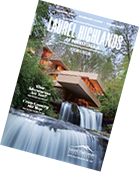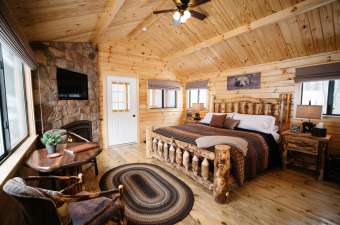New York Times: by Stephen Heyman
In 1934, E. J. Kaufmann, a Pittsburgh department store magnate, took Frank Lloyd Wright to a section of untrammeled woods in southwestern Pennsylvania called Bear Run. Mr. Kaufmann hoped to build his summer home here, in a glen thick with maple and hemlock trees, where water pooled and then dashed over a sequence of cater-cornered rock ledges.
Wright approved of the view. He had dreamed of setting a house over a waterfall since his first travels to Japan, in 1905, where he bought a Hokusai print of a cottage perched beside a steep cascade. In this Appalachian wilderness, he finally found the right spot. He wrote to Mr. Kaufmann a few days later, saying that a “domicile has taken vague shape in my mind to the music of the stream.” This house would become Fallingwater, perhaps Wright’s most iconic design, and one of 10 structures by him that the United States nominated last year to become Unesco World Heritage sites.
Fallingwater was built out of hand-hewn sandstone, glass, concrete, steel — and smoldering indignation. Wright was desperate to one-up the European modernists, like Walter Gropius and Mies van der Rohe, who had run his career aground. Mr. Kaufmann, meanwhile, wanted to thumb his nose at Pittsburgh’s priggish ruling class, which declined to give a Jewish merchant (and noted philanderer) a seat at its power table.
Once built, Fallingwater was rapidly mythologized, its reputation goosed by everyone from Mr. Kaufmann’s self-aggrandizing son Edgar Jr. to the Museum of Modern Art, Ayn Rand and press barons like William Randolph Hearst and Henry Luce. “Without these interventions,” writes Franklin Toker in his authoritative 2003 study “Fallingwater Rising,” “how likely was it that a house in a remote forest 18 miles from the Mason-Dixon Line would become the poster child for modern architecture worldwide?”
Fallingwater now brings 160,000 visitors a year to this remote forest, which is sunk between the two westernmost ridges of the Allegheny Mountains, about 90 minutes south of Pittsburgh. The area, branded the Laurel Highlands, once rivaled the Poconos as a Pennsylvania resort destination. Gilded Age plutocrats hunted fox and summered in these hills. Plenty of holidaymakers are still drawn in by the strenuous charms of spelunking, white-water rafting and biking the Great Allegheny Passage, a 150-mile rail trail that almost grazes Fallingwater.
But much of the local culture seems, at first blush, hardscrabble and uninviting. Fayette County, the home of Wright’s famous house, is one of the poorest in Pennsylvania, its rolling landscape littered with a backcountry potpourri of churches, crumbling barns, gun shops and fast-food restaurants. There are farms, but few farm stands (to say nothing of farm-to-table restaurants), and after driving for a few hungry hours you may start to wonder whose cow you have to milk to get a slice of local cheese around here.
This judgment is understandable, but it’s also superficial. The deeper you dig into the Laurel Highlands, the more treasure you uncover, and soon the path to Fallingwater becomes almost as interesting as the house itself.








